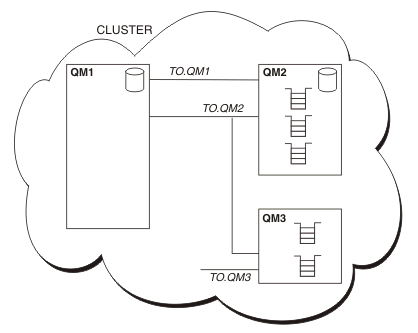Cluster components
An alternative to the traditional WebSphere MQ network is the use of clusters.
A cluster is a network of queue managers that are logically associated in some way. We can group queue managers in a cluster so that queue managers can make the queues that they host available to every other queue manager in the cluster. Assuming you have the necessary network infrastructure in place, any queue manager can send a message to any other queue manager in the same cluster without the need for explicit channel definitions, remote-queue definitions, or transmission queues for each destination. Every queue manager in a cluster has a single transmission queue that transmits messages to any other queue manager in the cluster. Each queue manager needs to define only one cluster-receiver channel and one cluster-sender channel.
Figure 1 shows the components of a cluster called CLUSTER:
Figure 1. A cluster of queue managers
- CLUSTER contains three queue managers, QM1, QM2, and QM3.
- QM1 and QM2 host full repositories of information about the queue managers and queues in the cluster.
- QM2 and QM3 host some cluster queues, that is, queues that are accessible to any other queue manager in the cluster.
- Each queue manager has a cluster-receiver channel called TO.qmgr on which it can receive messages.
- Each queue manager also has a cluster-sender channel on which it can send information to one of the repository queue managers.
- QM1 and QM3 send to the repository at QM2 and QM2 sends to the repository at QM1.
As with distributed queuing, you use the MQPUT call to put a message to a queue at any queue manager. You use the MQGET call to retrieve messages from a local queue.
For further information about clusters, see the WebSphere MQ Queue Manager Clusters book.
Parent topic:
How does distributed queuing work?
ic10290_
Home
